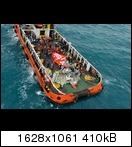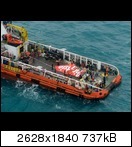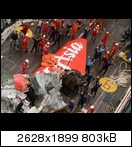Air Asia Indonesia Lost Contact from Surabaya to Singapore
Join Date: Feb 2008
Location: Asia
Posts: 96
Likes: 0
Received 0 Likes
on
0 Posts
So now we are back in the 'can-we-find-the-ULB-before-the-cheap-batteries-run-down' game again. All this extra work being proposed for streaming DFDR data is because the existing DFDRs are poorly designed their location systems are only useful in an inland lake or river (and perhaps not even then).
In the 'old days' before solid state memory there were all sorts of survivability issues; but with fast solid state memory with significant capacity this is not a problem. The real problem is the use of batteries that just do not have the power driving ULBs that are unsuitable for crashes in the ocean. Obviously, the beancounters at airlines are not interested, but it is time for an international mandate to have ULBs that actually work.
I would suggest that the ULBs requirements are:
Detection Range At least 25 nautical miles in open ocean
Battery Life At least 6 months, possibly by reducing number of pulses and using smart transponder that does not go into regular short location signals until it receives a search request sonar signal
Encoded Location Signals The signals from the ULBs should be encoded with airframe ID, their position (last GPS position of the aircraft) and their depth in the water.
These requirements appear to be asking too much and all that is being offered is a slightly longer life battery.
In the 'old days' before solid state memory there were all sorts of survivability issues; but with fast solid state memory with significant capacity this is not a problem. The real problem is the use of batteries that just do not have the power driving ULBs that are unsuitable for crashes in the ocean. Obviously, the beancounters at airlines are not interested, but it is time for an international mandate to have ULBs that actually work.
I would suggest that the ULBs requirements are:
Detection Range At least 25 nautical miles in open ocean
Battery Life At least 6 months, possibly by reducing number of pulses and using smart transponder that does not go into regular short location signals until it receives a search request sonar signal
Encoded Location Signals The signals from the ULBs should be encoded with airframe ID, their position (last GPS position of the aircraft) and their depth in the water.
These requirements appear to be asking too much and all that is being offered is a slightly longer life battery.
The technology already exists and is being used. My cousin said he routinely sends devices 6000 meters down in oceans and they will answer him back only after he transmits to them. The batteries last over a year.
Join Date: Dec 2005
Location: At home
Posts: 244
Likes: 0
Received 0 Likes
on
0 Posts
Video of recovered tail
Here is a video of the recovered tail section, presumably taken from the same helicopter as the photo in BJ-ENG's post. Good view at the 20-30 secs position.
https://www.youtube.com/watch?v=LG8i...ature=youtu.be
The size of the fuselage wall section is remarkably large (several windows) suggesting that the CVR and FDR were originally in that part of the plane. But it has broken up pretty badly IMHO from the point of view of finding the recorders.
PS: I think the fuselage has split along the bottom, and in the picture it is lying upside down on the ship's deck.
https://www.youtube.com/watch?v=LG8i...ature=youtu.be
The size of the fuselage wall section is remarkably large (several windows) suggesting that the CVR and FDR were originally in that part of the plane. But it has broken up pretty badly IMHO from the point of view of finding the recorders.
PS: I think the fuselage has split along the bottom, and in the picture it is lying upside down on the ship's deck.
Last edited by snowfalcon2; 10th Jan 2015 at 14:20. Reason: clarification
Join Date: Jan 2015
Location: Near St Lawrence River
Age: 53
Posts: 198
Likes: 0
Received 0 Likes
on
0 Posts
But the boat above detected faint ping sounds believed to be from the black boxes about one mile (1.6km ) southeast of the tail ... and covered in mud.
I think it could be in the opposite of where the tail was found ie northwest
Originally Posted by Nigel
Bear in mind these things do not directly save any lives, and assuming they find the Air Asia DFDR / CVR soon, just save some search effort.
Join Date: Sep 2014
Location: Canada
Posts: 1,257
Likes: 0
Received 0 Likes
on
0 Posts
I would suggest that the ULBs requirements are:
...
...
It's not as "easy" as just switching the frequency as there are many tradeoffs involved (power vs. range vs. frequency vs. rate of transmission vs. size vs. weight vs. cost vs. crash survivability, etc.)
SAE did a ton of analysis and in 2012 produced a new LF-ULB standard (AS6254), specifying 8.8 kHz for 30 days, with an assumed detection range of 5.8nm in normal conditions.
This standard has already been incorporated into FAA TSO C200, and accepted by ICAO in 2012 (Annex 6 Amendment 36) which mandates LF-ULB on all aircraft with MTOW > 27,000 kg starting from January, 2018.
ICAO mandate aside, in practice we will basically have two types of ULBs:
- Standard frequency 37.5 kHz ULB capable of operations for 90-days
- Low-frequency 8.8 kHz ULB capable of operations for 30-days
For shallow water recovery not far from shore (like this AirAsia crash), LF-ULB doesn't matter as much and 37.5 kHz will continue to be used for many years.
For deep sea recovery, aside from MH370 consider that in the past 20 years there have only been 6 airline accidents with wreckage submerged in 1000m depth or deeper. Of those, 100% of the FDRs and CVRs were successfully recovered using existing technology.
The FAA and EASA will likely require LF-ULB only for transoceanic flights (> 180nm from shore) starting in 2018 or 2019.
Join Date: Dec 2006
Location: Florida and wherever my laptop is
Posts: 1,350
Likes: 0
Received 0 Likes
on
0 Posts
But it was not 'the industry' that paid those extended recovery costs. 'The industry' was getting a free ride on the taxpayers of the location of the crash. In the same way that MH370 searches are being largely funded by Australian taxpayers.
Perhaps if 'the industry' or rather the airline and the manufacturer were billed for the costs of the recovery process, we would see a significant jump in the eagerness to get DFDR/CVR that could be rapidly recovered, as the cost to the Airline would be unsupportable. Attempts to insure against these recovery costs would result in the insurers demanding a better DFDR/CVR location system - or no insurance.
Perhaps if 'the industry' or rather the airline and the manufacturer were billed for the costs of the recovery process, we would see a significant jump in the eagerness to get DFDR/CVR that could be rapidly recovered, as the cost to the Airline would be unsupportable. Attempts to insure against these recovery costs would result in the insurers demanding a better DFDR/CVR location system - or no insurance.
Join Date: Dec 2014
Location: Schiphol
Posts: 475
Likes: 0
Received 0 Likes
on
0 Posts
Recovered tail plus ...
plumbrob, henra, smott999 - tail recovery
First impression is that we see part of the aft top fuselage panels down to the underside of the left and right exit doors. With 5 windows on each side. And 6 frames clearly identifiable, and upto 5 stringers under the windows. I have not seen floorbeams yet.
All lying upside down on the weather deck of the Crest Onyx of course.
The vertical tail looks suprisingly good. But a small part of the lower part of the rudder is torn away. Speculation - that might have happened when the tail with THS and APU were torn away.
On one of the recent pictures is a part that looks like the front end of the fuselage to wing fairing. Which looked pretty good. No information if it was recovered floating or underwater. First impression is floated.
First impression is that we see part of the aft top fuselage panels down to the underside of the left and right exit doors. With 5 windows on each side. And 6 frames clearly identifiable, and upto 5 stringers under the windows. I have not seen floorbeams yet.
All lying upside down on the weather deck of the Crest Onyx of course.
The vertical tail looks suprisingly good. But a small part of the lower part of the rudder is torn away. Speculation - that might have happened when the tail with THS and APU were torn away.
On one of the recent pictures is a part that looks like the front end of the fuselage to wing fairing. Which looked pretty good. No information if it was recovered floating or underwater. First impression is floated.
Last edited by A0283; 10th Jan 2015 at 16:23.
Join Date: Sep 2014
Location: Canada
Posts: 1,257
Likes: 0
Received 0 Likes
on
0 Posts
But it was not 'the industry' that paid those extended recovery costs. 'The industry' was getting a free ride on the taxpayers of the location of the crash. In the same way that MH370 searches are being largely funded by Australian taxpayers.
While governments initially fund searches, in many cases (such as MH370) extended operating costs will be charged back to the airlines, which in turn pay the charges from their insurance policy.
In the case of MH370, Malaysia Airlines has a $2.25 billion per crash liability policy with no caps for Search and Rescue. The Australian government has already reached out to Malaysia to seek reimbursement from this insurance fund.
In the case of AF447, Air France and Airbus directly funded the search for the blackboxes.
More relevant to this case (in Indonesia), Adam Air directly paid for the search and recovery the Adam Air 574 black boxes.
No doubt similarly AirAsia (and their insurer) must absorb / reimburse a large portion of the SAR costs.
For more "routine" recovery operations, governments typically do not charge back the airlines, but that's because the airlines and flying public already pay billions in taxes each and every year for routine government services (which include SAR).
Join Date: Jul 2009
Location: Not far from a big Lake
Age: 81
Posts: 1,454
Likes: 0
Received 0 Likes
on
0 Posts
But it was not 'the industry' that paid those extended recovery costs. 'The industry' was getting a free ride on the taxpayers of the location of the crash. In the same way that MH370 searches are being largely funded by Australian taxpayers.
Perhaps if 'the industry' or rather the airline and the manufacturer were billed for the costs of the recovery process, we would see a significant jump in the eagerness to get DFDR/CVR that could be rapidly recovered, as the cost to the Airline would be unsupportable. Attempts to insure against these recovery costs would result in the insurers demanding a better DFDR/CVR location system - or no insurance.
Perhaps if 'the industry' or rather the airline and the manufacturer were billed for the costs of the recovery process, we would see a significant jump in the eagerness to get DFDR/CVR that could be rapidly recovered, as the cost to the Airline would be unsupportable. Attempts to insure against these recovery costs would result in the insurers demanding a better DFDR/CVR location system - or no insurance.
Hmmmm....Peekay4 refutes Ian's assertion, with the qualifier,
in many cases the operating costs will be charged back to the airlines,
As an interim measure, why don't we instead clone some of this dfdr/cvr data and store it in additional locations on the aircraft in hardened memory modules. Locations like the wing tips and vertical stabilizer tips would be good choices. If imbeded into lightweight cushioning/floatable material, possibly also equiped with a water activated ELT & pinger, we have upped our chances for swiftly locating crash scenes and recovering the data. Design the component to have a high probability of being released under crash loads and the problem will be significantly mitigated, without having to re-negotiate the international agreements.
Meanwhile, lets hope the pingers are still bolted onto the black boxes. It would be very discouraging to recover a solitary pinger with no reward.
Last edited by Machinbird; 10th Jan 2015 at 17:07. Reason: reflect peekay4's input
Join Date: Mar 2014
Location: Clinton WA
Age: 75
Posts: 74
Likes: 0
Received 0 Likes
on
0 Posts
Shape of tail debris
Fewer comments since tail raising on shape of debris than on search methods and batteries. More than anything the tail section looks like a paper bag popped open except for the fuselage face that impacted the surface which fragmented. Pics/vids in situ showed the section retaining some shape which has largely been lost in raising and under gravity out of the water. If other fueselage sections split similarly the large skin sections would have acted like sails in the current while sinking. I've looked at a lot of accident debris (though many fewer with water impact) and such large contiguous skin sections of 8501 laid open seem rare. Question whether the next section forward is found to be similar. Whether a flat belly flop, or a nose-first air compression of aft fueselage, or any other impact attitude still very unclear.
BJ-ENG's post on G's vs human body damage applied to public pics so far suggest lower end of G scale.
BJ-ENG's post on G's vs human body damage applied to public pics so far suggest lower end of G scale.
Join Date: Dec 2014
Location: Schiphol
Posts: 475
Likes: 0
Received 0 Likes
on
0 Posts
Thanks for this Smott999 - tail damage
Cannot remember ever seeing damage like this. Perhaps someone has an example.
More common to see a separated "complete tail-section", or separated "vertical tail plus rudder".
Pure speculation. To imagine getting something like this, using an aircraft model, you would grab the "front fuselage and wing" with your left hand and hold it tight. Then with the other hand grab the horizontal stabilizer and rotate it till "it" breaks off.
This would also give an idea about why, more forward, the top fuselage panel was torn from the stiffer lower section. The remaining top part then rotates with the heavy tail down and the panels flatten when hitting the water. The remaing top part has more 'lift' than the lower section. So could move further.
Wonder where that lower section is. The why and how of this scenario ... has to wait for far more data and photos.
As far as I know the span of the horizontal stabilizer is 12.45 m and the distance from the top of the fuselage to the top of the vertical tail is about 5.87 m. If someone wants to make a 'torsion' calculation.
More common to see a separated "complete tail-section", or separated "vertical tail plus rudder".
Pure speculation. To imagine getting something like this, using an aircraft model, you would grab the "front fuselage and wing" with your left hand and hold it tight. Then with the other hand grab the horizontal stabilizer and rotate it till "it" breaks off.
This would also give an idea about why, more forward, the top fuselage panel was torn from the stiffer lower section. The remaining top part then rotates with the heavy tail down and the panels flatten when hitting the water. The remaing top part has more 'lift' than the lower section. So could move further.
Wonder where that lower section is. The why and how of this scenario ... has to wait for far more data and photos.
As far as I know the span of the horizontal stabilizer is 12.45 m and the distance from the top of the fuselage to the top of the vertical tail is about 5.87 m. If someone wants to make a 'torsion' calculation.
Last edited by A0283; 10th Jan 2015 at 17:34. Reason: Spit part cut to focus on QZ8501. Spott999 no suggestion intended :-)
Join Date: Oct 2005
Location: Classified
Posts: 314
Likes: 0
Received 0 Likes
on
0 Posts
What we really need is longer lasting batteries AND a stronger pulse. The arbitrary spec requirement from the past has well and truly been proven inadequate. Fix it!
Join Date: Jan 2008
Location: Herts, UK
Posts: 748
Likes: 0
Received 0 Likes
on
0 Posts
http://www.pprune.org/members/440631-a0283
AO283
I think you are confused...
Spittfire tails did not come off. Perhaps you mean Hawker Typhoon
or Tempest? (which did lose tails during development).
the Spitfire in all it's guises over a 10 year development period
was considered incredibly strong and it had to be, having the highest
Critical Mach No of any piston/prop powered fighter, demonstrated repeatedly
post war from altitudes as high as 50,000.
AO283
I think you are confused...
Spittfire tails did not come off. Perhaps you mean Hawker Typhoon
or Tempest? (which did lose tails during development).
the Spitfire in all it's guises over a 10 year development period
was considered incredibly strong and it had to be, having the highest
Critical Mach No of any piston/prop powered fighter, demonstrated repeatedly
post war from altitudes as high as 50,000.
Join Date: Aug 2012
Location: Wales
Posts: 532
Likes: 0
Received 0 Likes
on
0 Posts
From the picture of the tail section, it is obvious that the heavy APU was torn out of its position. Maybe it caused the nibble to the lower part of the rudder.
Are the black boxes bolted to the pressure hull, forward of the unpressurised tail section?
Are the black boxes bolted to the pressure hull, forward of the unpressurised tail section?






